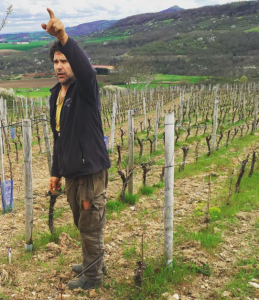Pierre Beauger makes wine, but not in any straightforward sense. At lunch some time ago, smelling a bottle of Pierre’s impossibly rich Sauvignon Blanc, Philippe Jambon delivered a typically cryptic verdict: “This is not wine. But, then again, Pierre Beauger is not a man.” Philippe’s lapidary insight deftly describes the mystery of Pierre, a radical free-thinker, rarely spotted in public, who works in a fashion that can only be described as superhuman. On a 3.5 hectare plot of land, high up on a hillside amongst the long dead volcanoes of Auvergne, in central France – “Edenic” just about describes the atmosphere – Pierre farms Pinot Noir, Sauvignon Blanc, Pinot Gris and Syrah. By the time he picks his first grapes, all of his neighbors have already completed their fermentations—which is to say, he harvests late, extremely late, in pursuit of a ripeness outside of the realm of wine. Each cluster is picked and then carefully examined for berries that may have been damaged by birds. Those berries are removed and any juice that may have spilt on the cluster is licked off—by which I mean literally licked off with one’s tongue. The cluster is then smelled. If any volatile qualities are present, the cluster is turned to the sun so that other undesirable berries can be detected by their color—purple is good, gray is not. (Pierre detests VA and will go so far as to throw out entire barrels of wine if he detects any.) Raisins are fine, as long as they are healthy. The only sure way to know a berry is good is to eat it. Clusters are then carefully nestled into a bucket—never dropped. Catherine Dumoura, Pierre’s friend and fellow winemaker, echoed Philippe’s comment as we were harvesting together one afternoon. Carefully examining a cluster of Pinot Noir, she remarked, “This is madness. Pierre does not make wine. He makes art.”

Pierre Beauger, in his vines at Champeix
For the clusters lucky enough to make it into Pierre’s winery, the cellar work is suprisingly uncomplicated and free of fancy technology. All wines are pressed whole-cluster on a vertical, manual press. After fermentation, they are racked into old barrels, where they will rest for anywhere from 9 months to 12 years. Pierre is a master of elevage, which is to say he has a gift for patience and an intuitive abiliity to detect the subtle point of equilibrium between fruit and oxygen. No additives are used at any point in Pierre’s winemaking.
Pierre’s wines are not easy to obtain and, given his painstaking methods of production, not particularly cheap. There are some who accuse him of cynical market speculation—though anyone who has spent time with Pierre knows otherwise. Rather, as Catherine observed, like pieces of art, Pierre’s wines feel eccentric to the logic of supply and demand. A better model for understanding their role in the natural wine world might be that of patronage, which continued in the art-world long after capital had domesticated all other aspects of human economics. Indeed, from a certain perspective, his creations bear more resemblance to Cy Twombly’s Leda and the Swan or Caravaggio’s Supper at Emmaus than to wine. Our attempts to describe how they “taste” inevitably descend into some combination of physical yearning, celestial luminosity and primitive forms of abstraction. How to translate the pleasure of a wine whose color seems to have been leached from from the slick scales of an Angelfish? Whose aromas arise from the unfathomable conjugation of rancid mango and a decomposing branch of ancient cedar covered in decades of moss? Whose texture was spun deep inside the dreamscape of a child? In their dazzling intensity, Pierre’s wines bring us all the way to the brink of what wine can be, and perhaps just a bit beyond—which in the end is nothing other than returning us to where we began. Do we know where we began? Pierre relentlessly asks us the question.
-B.T.
